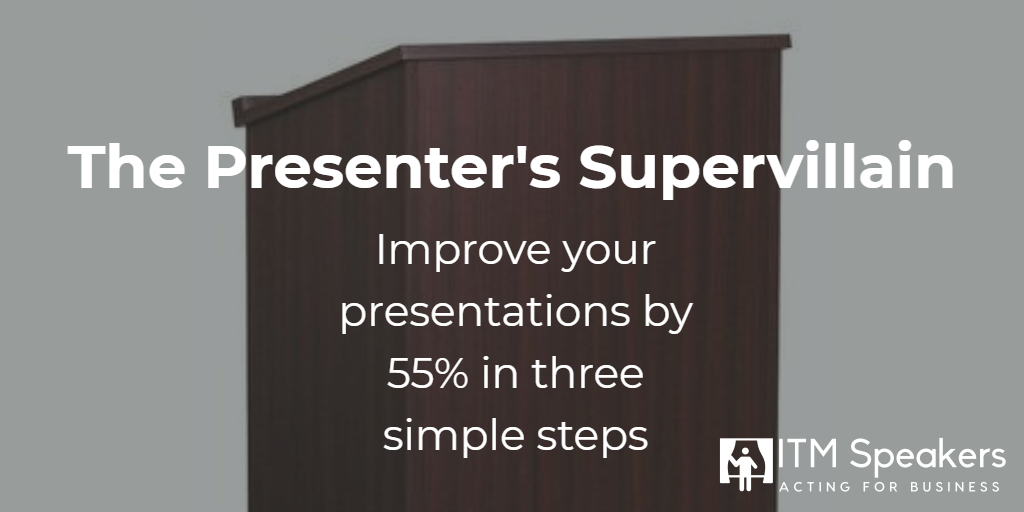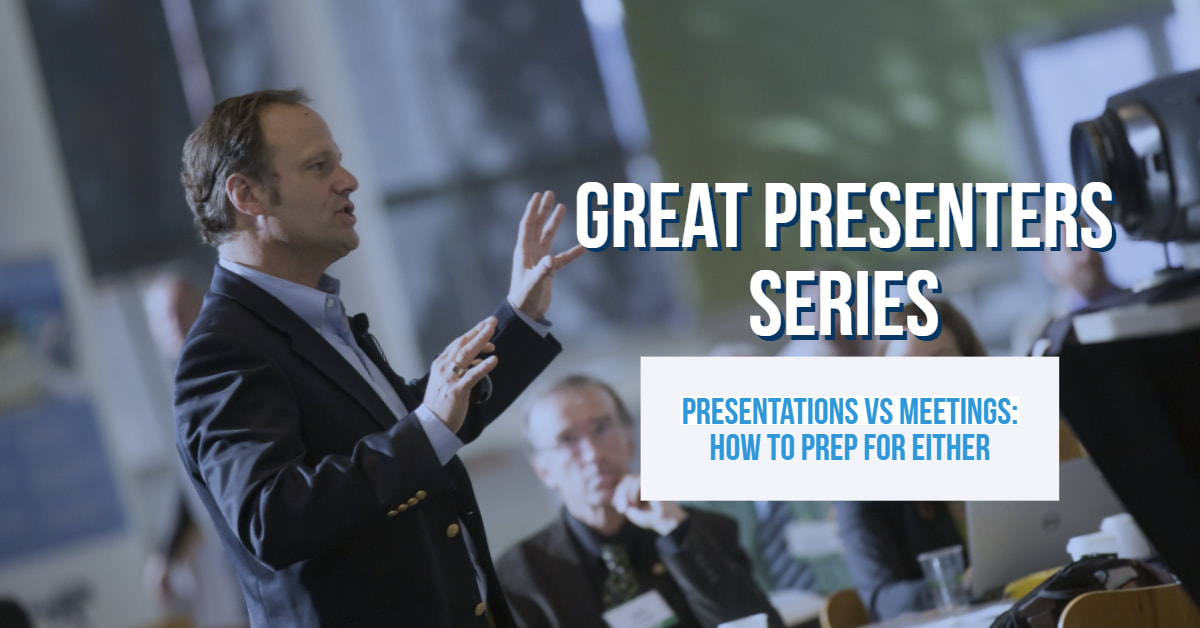|
In a meeting with a speaker the other day I heard, “I love using a podium because it gives me somewhere to put my notes.”
Fortunately, I had a whiteboard handy and I wrote down the following numbers. 7, 38, 55 I asked him if he knew what they represented, and he said no. These numbers are well known to speakers and are the percentages of how people consume information when listening to a speaker.
I asked him how much of his body people could see if he was standing behind a podium. He said that it depended on if his laptop was on the podium. “Laptop,” I asked? “So I can see my note in presenters view and click my slides,” he replied. So, right there he confirmed three bad habits. First, he hides behind a podium, eliminating most of the 55% of information from body language. Second, he doesn’t use a presenter’s clicker to move his slides. That means he’s tethered to the podium. And third, he’s constantly checking his notes, losing his connection with the audience. Podiums are poison to presentations and come from a time where formality was the norm. If you want to be an effective speaker you have to be confident and own your presentation space. If 55% of your information is coming from your body language, why hide 75% of your body behind a piece of furniture? If you plan to roam the stage and own your space you need to get used to a presenter's mouse. Even if you are just in a meeting, it will free you from leaning over your laptop. Go to Amazon and search for “presenter’s mouse”. The one I use was just the cost of a couple large lattes. It's a great investment. Finally, notes are fine, but they are usually a sign of insufficient rehearsal. You don’t want to use too many data points at once. A good speaker can casually drop in major points such as, “Sales up by 32% last quarter,” or “Jim was having a meeting in Leeds, England.” By not constantly referring to notes you’ll be seen as an expert and not a reader. But, if you have to reference a piece of information on a slide, take a quick look confidently and then refocus on your audience. We’re all human and sometimes we forget things. Be definitive. Podiums are a crutch. Most people use them because they are afraid of being out in the open. If you’re ever tempted to use a podium remember the 7-38-55 rule and ask yourself, “Would I ever leave out 55% of my words?” If you use a podium that’s how much information you’re not giving your audience.
0 Comments
In a recent class a client asked about the differences between techniques that can be used for a formal presentation versus a conversational meeting. It’s a good question, because while there is a lot of overlap there are differences.
Most meetings and presentations follow a 3-act structure. This structure is what you see in most hit movies, intro - confrontation/conflict - resolution. You meet the characters and learn about their motivations, there is some motivation that sets the hero or heroes into a battle or challenge, then a moment or change that drives the hero to the final confrontation and the ending. In Star Wars, you meet Luke, C3PO, R2D2, Princess Leia, Darth Vader and a few others, during the first act. Luke sees the burned out remains of his Uncle and Aunt’s farm and we’re on to the second act where Luke matures into a young Jedi. Once Leia is rescued and Luke sees Ben “killed” by Vader the final resolution starts as the attack on the Death Star is planned. This isn’t very different than a business presentation or meeting. Well except for the blasters, robots, space stations and a few other details. The core is the same whether you’re involved in a formal meeting or status review. Act 1: The Introduction In a formal presentation that is more of a 1-side speech than interactive you need to capture your audience's attention with a hook. Why should they listen? Are you an authority on a subject? Does it relate to the audience well? Is the audience going to learn something personally relevant or compelling? Are you giving the audience a structure they can follow, or something that is so intriguing that they are on the edge of their seat to learn the next twist of the story? One thing is to make sure that it’s clear what will be covered by the end of the session. “You will learn why you should consider getting rid of every copier in your office in 45 minutes” or something similar. Give them a clear understand of what you want the audience to learn or what viewpoint you will share and potentially convince them of the validity of your argument. In a status meeting it’s often more about giving attendees a structure that they can follow. That helps for two reasons; the first is for the multi-taskers in the room, and you know who you are, will then at least know when to switch their full attention back to the meeting. For those that are involved from beginning to end, they have a “story” to follow, even if that story is simply where the project is, what challenges came up last week, and then what the next steps are going to be. Act 2: The Confrontation For the formal presentation the confrontation is usually your argument or body or the topic. If your set up was why athletic wear should be made in the US versus abroad, this is where you lay out your reasons why it makes sense. In a more interactive meeting information is still presented, but the conflict hopefully is clarifying questions, new ideas and problem solving. The goal is to control the meeting so that this section aligns to cover the agenda and goals you’ve defined in your intro. Act 3: The Resolution You’re in control with a formal presentation. You can build your argument until your moment of truth, and then hit the summation with a twist, a wall of momentum, or a simple re-listing of your originally stated goals. It’s all up to you. But, make sure you hit it with conviction. You are sharing a truth, even if you think you’re approach is just an option for your audience. Show the passion of why your viewpoint is vital for the audience to consider, implement or carry forth to the world. If you’re hosting your weekly status meeting you might not be destroying the Death Star every week. But you are celebrating progress or overcoming obstacles. It’s your job to keep driving progress forward. Celebrate your victories, build your strategy for challenges and share the plan for the next week. Hold people accountable for wins and losses and get them to sign up for the next leg of the project. Drive your momentum with certainty and conviction. Beginning, middle and end. Every good story has them. Whether you’re standing on a stage in front of 1,000 strangers at a conference, or sitting with your team with a couple of people from your client on a conference call.It’s not that different. Start with the ending and know what you want to accomplish. Use the three act structure and lead them. Leadership is what a good structure shows, and that is the same for presentations or meetings. I just finished teaching two classes this week on presentation skills and signed up a new client that will be doing keynotes throughout the year, and one thing keeps floating to the top for me about what makes a great presenter.
It starts with knowing who you are and deciding who you will be. In my class we talk about picking your character. Now that doesn’t mean creating something fake, although some people do. It’s about picking the facet of who you are to build your personal brand. When the late, great Steve Jobs was on stage you were listening to a visionary/technologist. When I sat in the audience and listened to Robyn Benincasa, who holds world’s records in long distance kayaking and is a champion adventure racer, firefighter, and author, I was listening to an inspiration speaker. Larry Ellison of Oracle comes at you with bombast and his unique viewpoint and is a contrarian. Steve wanted to lead you to a better world. Robyn wants to show you that you have no limits. Larry is telling you the way things will be whether you agree or not. Each personal brand drives these speakers’ topics, styles and how audiences react to them. So, who are you? We are not all company leaders or world class athletes, but we are all unique. We all bring something that is the core of us to the table. Here are a few examples of what the attendees of my class came up with to define their personal brands. Leader/Nurturer – Leads the way with direction, passion and purpose, but wants each team member to be fulfilled and get the most out of the experience Expert – Knows the specific subject at hand and isn’t afraid of the toughest questions Sherpa – The enabler, there to support others to achieve their goals Director – Authority figure that will pick the goal, set the direction and make sure things get done Teacher – Helps others with techniques to acquire new skills Entertainer – Focuses on keeping the mood light while teaching any subject When a presenter walks on stage for the first time, or the 100th, he or she is working to create or reinforce their personal brand. Guy Kawasaki has a brand focused around his insightful business ideas, offbeat style, and approachable personality. He’s a friendly mentor. I would walk up to Guy and ask for a selfie. I don’t know if I would do that with Larry Ellison. I’ve never met either, but I think Guy is more likely to smile and shake your hand. Larry probably has security people. Being a great speaker and communicator takes credibility. People have to believe that you know and believe in your topic. So ask yourself three questions:
The Empire State building has been standing for 87 years, and is known worldwide. It was built on a solid foundation. If you build your personal brand around who you are you’ll have a foundation that could make your talks world famous for years as well. Hi, my name is Rob and I’m a presentation abuser. In fact, I’ve been using presentation software for decades. I used a great product called Astound by Gold Disk in the 90s that did animation way before anything out of Redmond had those features. I speak fluid PowerPoint and have seen, and done, the best and the worst with it. But, now I need to own up and share some of the worst practices that organizations do every day, and could change if they just paid a little attention and put in some effort. PowerPoint is a Backdrop, not a Movie This is rampant throughout nearly every sales presentation. Presenters create slides that are like a Microsoft Word document that take the attention of the viewer away from where it should be…the speaker! Think of the presentations of Steve Jobs as a great example. There Steve is on a stage and behind him is a giant picture of an iPhone™, or iPad™, or iBuilding™, or iGrandmother™. The image is the frame, but what Steve is saying is the art. 99% of the time words on a slide are a crutch. Learn the content. Learn the story. Learn to walk without the crutch. Presentation Deck or Training Deck. Pick one. The reason that many sales presentation decks in particular are long, wordy messes is that Marketing departments use them to primarily train sales people. I’ve seen this in company after company. While some “Sales Decks” have good notes on each slide with talking points they are usually ineffective. The reason why is that they are either long paragraphs that people don’t want to read, scripted words that Sales people won’t use, or in the best case, bullet points of specifically created important talking points that will most likely be ignored. A better practice is to only create a high impact, highly graphical deck that is used by people to present the topic. Avoid creating any deck that includes slides that could be easily pulled into an audience facing deck. If you need to create a script, put it in a PDF document with images of the slides from the highly graphical deck. In short, make it harder for people to do the wrong thing, and easier for them to take the right path. At Least Learn to Use the Tool Correctly I’ve worked with brilliantly creative people that occasionally drove me crazy. As a Marketing professional you are in the 1-to-many business. Everything that you create will be used, viewed or reused by hopefully dozens to millions of people. Always create with an eye to how people will reuse your stuff. In the world of PowerPoint, that means templating. I have friends that refuse to use templating and approach every slide as if it was a Picasso painting. They lay it out beautifully and artistically, and it does look great. However, they will be sending out their brilliant work to the great unwashed that will grab three slides from this deck, seven from another, and drop it something from a Google search to fill out their ideas. Without using templating each slide will have to be hand adjusted…or most likely won’t…to look consistent. I understand that templates limit creativity, but then learn how to create some interesting templates and make everyone’s life easier downstream. Granted, if you just have a picture of iGrandmother™ on the screen you won’t need much in the way of templating, but there will be a time for words that can’t be avoided. Rules to Live By
PowerPoint is a necessary evil for most people. Personally, I would prefer to see its use minimized to make presenters focus more on their communications skills and storytelling, but even a Broadway show needs a set. Stories are memorable. I know that goes without saying, but a story that includes a statistic is more than a dozen times more memorable than a statistic alone. So, why aren’t we better at telling stories? It comes down to a few simple approaches. Tell stories people want to hear, not just the ones you want to tell. This is a major issue with most corporate storytelling. The author has something they want to say and tries to force it into a story form. Usually it’s a product, viewpoint, service or news item. The most important thing is to put yourself in the shoes of your target story consumer and ask yourself, “Would I want to read this?” Use this simple hierarchy to drive your thinking
For example, if I read an adventure article that describes an exciting trip down the Amazon in a kayak, I could learn about paddling techniques and the importance of certain types of paddles that can lead me to purchase one from a company that provides such an item. Lead with your hero and mission If you want to tell a story about how your company is a great place to work, pick an interesting angle to build your story around. It could be your flexible work policy, or how you support community projects. Start with your hero and his or her mission. For example: Jennifer is devoted to volunteering at the greyhound adoption shelter helping ex-racers find new homes. Every third Thursday afternoon she gathers donations of dog food and cleaning supplies and brings them to the shelter. She’s able to do this due to the Flex-work program at your company. The combination of an employee, community service and helping retired greyhounds will connect the reader or listener with how a noble mission is being supported by the policies of the employer. The Five Ws and the right vehicle Every journalist knows the five Ws; who, what, when, where and why. There is also the one H for “how” that is in the conversation. Each area of detail creates a picture in the mind of the reader, listener or viewer. The more concrete the details, the better their connection with the content. Video and audio provide an edge for some of these elements, so the vehicle for your story is important to consider. Do you have a speaker with a great and emotive voice? Consider a podcast. Does your story take place in a YMCA with rock climbing walls, childcare and senior citizens practicing Tai Chi? Shoot a video. When crafting a story, the goal is to connect with the audience, so figure out how to create a story that is more like an episode of CSI than a datasheet, and you’ll be well on your way. |
Categories
All
Robert MattsonRobert is a speaker coach, actor, director, author, speaker, executive and overall marketing guy. He writes about all aspects of presenting and connecting with audiences. Archives
April 2019
|






 RSS Feed
RSS Feed